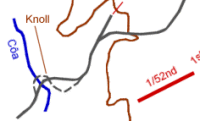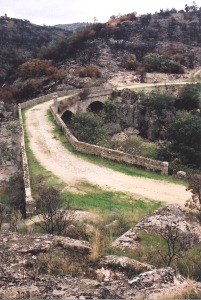
After the valiant resistance of General Andrès Herrasti's garrison at Ciudad Rodrigo came to an end on 10th July 1810, the French army of Marshal André Masséna was free to move against the Portuguese fortress town of Almeida. After his army had been re-supplied with food, ammunition and draught animals, Masséna issued orders to Marshal Michel Ney on 21st July for the 6th Corps to advance on Almeida. In the face of the French advance, General Robert Crauford, commanding the British Light Division, blew up the isolated Spanish fortress of Fort Concepcion and withdrew across the border into Portugal. Rather incautiously, Crauford chose to attempt to shield Almeida by holding a line east of the Côa river with a force of only 3,500 infantry and 1,200 cavalry. In the early hours of 24th July, after a night of torrential rain, Ney pushed forward his entire force of 24,000 men against Crauford's line. Strung out over a 3km-long front, the line was held from left to right by the 1/43rd, 3rd Caçadores, 1st Caçadores and 1/52nd with the 1/95th partly with the 1/43rd and partly dispersed along the front. Shortly after daybreak, Crauford's 5 battalions came under attack from 13 battalions of Loison's Division. No sooner had the first French attacks been checked by intense musket- and rifle fire than several hundred cavalry of the French 3rd Hussars braved the fire of the guns of Almeida and drove in the left flank of Crauford's line, practically annihilating a company of the 1/95th. With his line in danger of being rolled up from the left, Crauford ordered an immediate retreat to the bridge over the Côa. Whereas the Caçadores were ordered to follow the guns and cavalry down the road to the bridge, the three British battalions strived to hold off the enemy while falling back from the left. The flight down the road was held up after an overturned wagon blocked the way, and not all the guns had crossed the bridge by the time the British battalions had been driven back to the river. While Crauford hurriedly deployed his guns and the Caçadores so as to cover the bridge from the slopes on the western side of the river, the British infantry guarded the approach to the bridge by occupying the rocky knoll above it.
Had Ney ended his attack at this point, he would have secured a clear victory; at little loss to themselves, the French had inflicted 300 casualties while driving the Light Division across the Côa. Instead, Ney ordered the bridge to be stormed. In the first attempt, grenadiers of the 66th surged down the knoll but, under a hail of musket- and cannon fire, failed to get further than halfway across the bridge. The second and most strongly-pressed attack was made by the Chasseurs de la Siège, an elite light infantry battalion. Oman wrote of how they "flung themselves at the bridge, and pushed on till it was absolutely blocked by the bodies of the killed and the wounded, and till they themselves had been almost literally exterminated, for out of a battalion of little more than 300 men 90 were killed and 147 wounded in less than ten minutes." The third and final attack was again made by the 66th; less determined than the two previous assaults, it was beaten off with little difficulty. After the debacle at the bridge, French casualties totalled 527, whereas the Light Division had lost 318. At midnight, Crauford withdrew on Pinhel, leaving Masséna at liberty to lay siege to Almeida. Travelling north on the N332 from Vilar Formoso, turn left on the N340 signposted Pinhel (just before reaching Almeida). The road descends to the Côa river. Cross the river by the new bridge and park off the road to the left. Walk down the track to reach the old bridge. "A History of the Peninsular War, Volume III" by Sir Charles Oman, published by Greenhill Books 1996, ISBN 1853672238. "Costello: The True Story of a Peninsular War Rifleman" by Eileen Hathaway, published by Shinglepicker 1997, ISBN 0952278235. Robert Burnham's article on the action on the River Côa. Map of the Côa courtesy of The Napoleon Series. © Andrew C Jackson 2003
|

